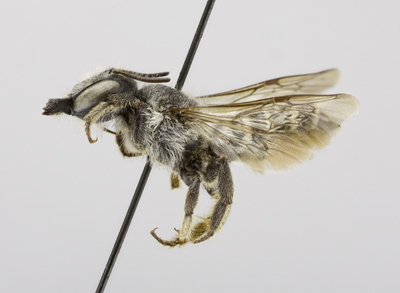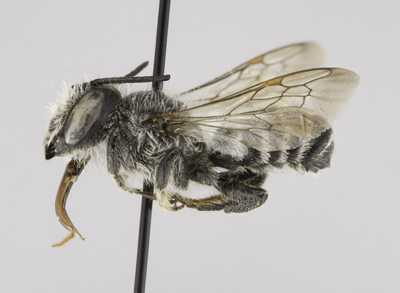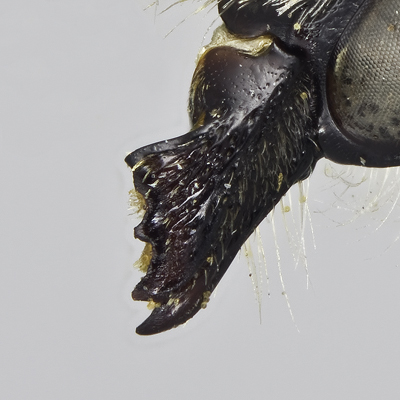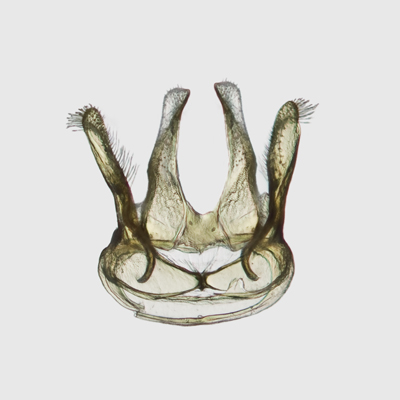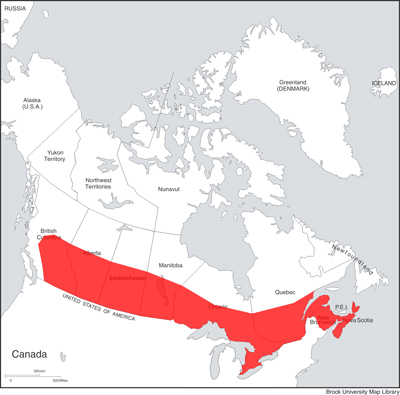
17. Megachile (Megachile) montivaga Cresson, 1878
Megachile montivaga Female |
Megachile montivaga Male |
Megachile montivaga Cresson, 1878. Trans. Amer. Entomol. Soc. 7: 124 (♀, ♂).
Megachile helianthi Cockerell, 1908a. Ann. Mag. Nat. Hist. (8) 1: 259 (♀).
Diagnosis.The female of M. montivaga can be recognized by the combination of 5-dentate mandibles without cutting edges (often appearring 4-dentate), T6 distinctly concave in profile with few erect hairs visible except laterally, and an entirely pale scopa. They are most similar to M. ericetorum. The female of M. ericetorum has distinct 4-dentate mandibles, and the apical edge of clypeus with a small median tubercle. The male of M. montivaga can be recognized by the combination of simple and dark front tarsi, front coxal spine represented by an acute, dentiform tubercle, 3-dentate mandibles with the teeth equally spaced, clypeus without a prominent median tubercle on apical margin, and T6 being rather strongly protuberant medially. They are most similar to M. inermis. The males M. inermis have 3-dentate mandibles with the 2nd tooth much nearer the apical tooth than the 3rd tooth.
FEMALE: Length 11-13 mm.
Head:
Figure M17: Megachile montivaga female mandible |
1) compound eyes very slightly convergent below; lateral ocelli slightly nearer eyes than margin of vertex (7:9), 2) clypeus slightly convex, apical margin nearly straight and impunctate medially, 3) mandibles obscurely 5-dentate, the 4th tooth a slight angulation between 3rd and 5th teeth, with no cutting edges (Figure M17), 4) gena subequal to compound eye in width, 5) punctures of vertex deep and distinct, close, though more separated laterally, becoming somewhat more shallow and close on gena, finer and more densely crowded on frons and paraocular area, supraclypeal area and clypeus with a shining, medial impunctate band, punctures becoming quite deep, distinct and close laterally, 6) pubescence of head mostly pale, rather copious but short around antennae, paraocular area, and gena below; vertex with long sparse pale hairs along posterior margin, with dark hairs in ocellar triangle and below median ocellus extending onto vertex laterally, 7) F1 longer than broad (2:1.5), slightly longer than pedicel and F2, which is quadrate, remaining flagellomeres subquadrate to very slightly longer than broad, apical flagellomere more elongate (5:3).
Mesosoma:
1) pubescence almost entirely pale, rather copious but not obscuring the surface, short laterally and posteriorly; mesoscutum and scutellum with sparse pubescence, mostly pale, with an intermixture of dark pubescence anteriorly on mesoscutum, 2) punctures of mesoscutum quite close, deep, distinct, slightly separated in centre of disc; punctures of scutellum finer than on mesoscutum, slightly separated medially, becoming crowded laterally, very fine and densely crowded on axilla; punctures of pleura distinctly but not widely separated below, rather deep and distinct, becoming somewhat finer and very close above; propodeum relatively smooth and somewhat shining with well spaced shallow punctures, triangle impunctate, somewhat shiny, 3) basitarsi of all legs somewhat narrower and shorter than their tibiae, spurs yellowish-brown, 4) tegula very finely and rather closely punctate, becoming impunctate along outer margins, 5) wings lightly infuscated, veins black.
Metasoma:
1) T2-T4 quite deeply grooved across base, basal margins of grooves somewhat carinate, T5 with a similar, very shallow groove that is poorly defined medially; apical margins depressed only toward sides on T2 and T3, quite deeply depressed across entire width of T4 and T5, quite densely white fasciate, the fasciae more or less interrupted on the more basal terga; discs of terga somewhat shining, finely and rather sparsely punctate medially, becoming somewhat closer only at extreme sides, but punctures basal to grooves somewhat closer and deeper, although finer; discal pubescence relatively elongate, sparse and entirely pale on T1, very short, fine and erect on remaining terga, black apically on T3, entirely so on T4 and T5; T6 distinctly concave in profile, with few erect hairs visible except laterally, surface very finely and closely punctate, punctures becoming inevident apically, surface very finely white tomentose toward apex, 2) S6 with scattered scopal hairs toward base, but quite bare over apical half, with an apical fringe of very short, pale hairs; scopa otherwise pale yellow; sterna closely, deeply and finely punctate on the more basal segments, becoming somewhat more sparse and coarse apically, apical margins very narrowly yellowish-hyaline.
MALE: Length 9-11 mm.
Head:
1) compound eyes slightly convergent below; lateral ocelli slightly nearer margin of vertex than eyes (5:6), 2) clypeal margin nearly straight, a few crenulations medially, 3) mandible 3-dentate, lower process sharply acute, subbasal in position, 4) gena slightly broader than compound eye (8:7), 5) punctures of vertex rather fine, deep and distinct, close medially, but somewhat more widely separated laterally, those on gena uniformly close and fine, somewhat coarser and slightly separated on frons just below median ocellus, otherwise very fine and densely crowded over most of face, slightly separated only in centre of clypeus and along its upper margin, very fine and dense apically, 6) pubescence entirely pale on head, pale yellow to white and quite dense around antennae and over lower half of face, on gena below, becoming rather short above, becoming rather short and sparse on vertex, with a few shorter, inconspicuous, darker hairs evident on vertex and upper inner margin of compound eyes, 7) F1 about as long as broad, longer than pedicel, shorter than remaining flagellomeres, which are slightly longer than broad (2.5:2), apical flagellomere elongate, about twice as long as broad.
Mesosoma:
1) pubescence entirely pale, rather short and sparse dorsally, dense and white laterally and posteriorly, 2) mesoscutum dull, punctures quite shallow, not very coarse, slightly separated medially, becoming closer anteriorly and posteriorly, uniformly close and fine on scutellum, and very fine and crowded on axilla; pleura dull, punctures fine and uniformly crowded; propodeum somewhat smoother, shining, with fine, well-spaced punctures, triangle dull and impunctate, 3) front coxal spine represented by an acute, dentiform tubercle, legs somewhat reddened, basitarsi much shorter and narrower than their respective tibiae, mid tibial spur rather short but well developed, spurs yellow, 4) tegula yellowish-brown, minutely and rather closely punctate, 5) wings subhyaline, veins brownish-black.
Metasoma:
1) T2-T4 with complete, transverse, basal grooves, basal margin of these rather distinctly carinate, apical margins rather deeply depressed laterally but not medially, depressed areas white fasciate; T1 with rather long, erect, entirely whitish pubescence, that on T2 very short but evident, discal pubescence on T3-T5 mostly sparse, short and erect black hair, T5 with sparse, erect and rather elongate, pale hairs in addition to dark hairs; T1 very closely and finely punctate, punctures becoming successively more distinct and somewhat more coarse on the more apical terga, well separated but not sparse on T5, T6 dull, punctures fine and densely crowded except across the narrow base, rather strongly protuberant medially, carina with a shallow, median emargination and slightly, irregularly crenulate on each side, median teeth of apical margin carinate, much nearer the acute, slender, lateral teeth than to each other; T7 clearly evident, short, transverse, quite deeply concave just basal to margin, 2) S1-S4 exposed, punctures quite close and rather fine, apical margins of S2-S4 abruptly and quite deeply depressed, clear hyaline, rather conspicuously fringed with elongate, whitish hairs except medially on S4.
Genitalia: Figure G17.
|
Figure G17: Megachile montivaga genitalia |
Discussion:
Unlike other members of the subgenus Megachile in North America, females of M. montivaga collect flower petals instead of leaves for nest cell construction. Although reported to accept trap-nests (Baker et al. 1985), this seems to be an uncommon event (e.g., Ivanochko 1979; Sheffield et al. 2008) and the bee may preferentially nest in soil (Table 1). Uncommon compared to most members of the subgenus Megachile. The synonymy of M. helianthi (from Colorado) with M. montivaga is recent (Scott et al. in press, via pers. comm. with John Ascher, American Museum of Natural History).
Distribution:
Found throughout southern Canada, from NS-BC (see Map 17).
|
Map 17: Canadian distribution of Megachile montivaga |
